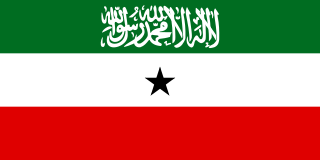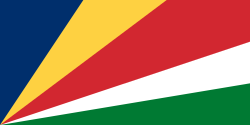
The flag of South Africa was designed in March 1994 and adopted on 27 April 1994, during South Africa's 1994 general election, to replace the previous flag used from 1928–1994.

The national flag of Djibouti is a horizontal flag bicolor with equal bands of light blue and light green, with a white, equilateral triangle at the hoist. In the center of the triangle is a red star. The flag combines the basic layout and colors from the flag of the Front de Libération de la Côte des Somalis. The light blue represents the sky and the sea, as well as the Somalis, green represents the everlasting green of the earth, as well as the Afars, white represents the colour of peace and the five point red star represents unity, the blood shed by the martyrs of independence, as well as Djibouti being one of the five regions inhabited by the Somali people.

The flag of Newfoundland and Labrador was introduced in 1980 and was designed by Newfoundland artist Christopher Pratt. The flag design was approved by the House of Assembly of the province of Newfoundland, Canada, on May 28, 1980. It was flown for the first time on Discovery Day, June 24, 1980. The name of the province was changed to Newfoundland and Labrador by an amendment to the constitution of Canada in December 2001 at the request of the provincial legislature.

The flag of Iraq is the national flag of Iraq, includes the three equal horizontal red, white, and black stripes of the Arab Liberation flag, with the phrase "God is the greatest" in Arabic written in Kufic script in the centre.

The national flag of the Russian Federation is a tricolour of three equal horizontal fields: white on the top, blue in the middle, and red on the bottom. It was first raised in 1696, as an ensign for merchant ships under the Tsardom of Russia.

The national flag of Azerbaijan, often referred to in Azerbaijani as üçrəngli bayraq, is a horizontal tricolour that features three equally sized bars of bright blue, red, and green; a white crescent; and a centred eight-pointed star. The flag has become the predominant and most recognizable symbol of Azerbaijan. The bright blue represents Azerbaijan's Turkic identity, the red represents progress, and the green represents Islam, which is Azerbaijan's majority religion.

The national flag of Armenia, also known as the tricolour, consists of three horizontal bands of equal width, red on the top, blue in the middle, and orange on the bottom. The Armenian Supreme Soviet adopted the current flag on 24 August 1990. On 15 June 2006, the Law on the National Flag of Armenia, governing its usage, was passed by the National Assembly of Armenia.

The state flag of Belarus is a red-green bicolour with a red-on-white ornament pattern placed at the hoist (staff) end. The current design was introduced in 2012 by the State Committee for Standardisation of the Republic of Belarus, and is adapted from a design approved in a May 1995 referendum. It is a modification of the 1951 flag used while the country was a republic of the Soviet Union. Changes made to the Soviet-era flag were the removal of communist symbols – the hammer and sickle and the red star – as well as the reversal of the colours in the ornament pattern. Since the 1995 referendum, several flags used by Belarusian government officials and agencies have been modelled on this national flag.

The flag of Belize was adopted on 21 September 1981, the day Belize became independent. It consists of the coat of arms of Belize within a white circle on a blue field with red stripes at the top and bottom.

The State Flag of the Republic of the Union of Myanmar was adopted on 21 October 2010.

The flag of the Central African Republic was officially adopted in 1958. It has been retained since that time with the same design, four horizontal stripes of blue, white, green and yellow, and a single vertical band of red, with a yellow five-pointed star in the upper left corner.

The flag of Rwanda was adopted on 25 October 2001.

The current flag of Sudan was adopted on 20 May 1970 and consists of a horizontal red-white-black tricolour with a green triangle at the hoist. The flag is based on the Arab Liberation Flag of the Egyptian Revolution of 1952, as are the flags of Egypt, Iraq, Syria, Yemen, and Palestine and formerly of the United Arab Republic, North Yemen, South Yemen, and the Libyan Arab Republic.

The flag of Uganda was adopted on 9 October 1962, the date that Uganda became independent from the British Empire. It consists of six equal horizontal bands of black (top), yellow, red, black, yellow, and red (bottom); a white disc is superimposed at the centre and depicts the national symbol, a grey crowned crane, facing the hoist's side.

The flag of The Gambia is the national flag of The Gambia. It consists of three horizontal red, blue and green bands separated by two thin white lines. Adopted in 1965 to replace the British Blue Ensign defaced with the arms of the Gambia Colony and Protectorate, it has been the flag of the Republic of the Gambia since the country gained independence that year. It remained unchanged throughout the Gambia's seven-year confederation with Senegal.

In military organizations, the practice of carrying colours, standards, flags, or guidons, both to act as a rallying point for troops and to mark the location of the commander, is thought to have originated in Ancient Egypt some 5,000 years ago. The Roman Empire also made battle standards reading SPQR a part of their vast armies. It was formalized in the armies of Europe in the High Middle Ages, with standards being emblazoned with the commander's coat of arms.

The Blue Sky with a White Sun is the national emblem of the Republic of China (Taiwan).

The flag of Somaliland was adopted on 14 October 1996. It consists of a tricolour of green, white, and red, with a black star located in the centre. On the green stripe, there is the Shahada in white calligraphic script.

The coat of arms of the Republic of Seychelles shows a shield, in which a giant tortoise is located on green grounds. On the ground there is a coco de mer palm tree. Behind it there is a blue sea with two islands and a sail ship to be seen. The shield is enthroned by a silver helmet, on which a white-tailed tropicbird is located above blue and white waves. The shield is supported by two white sailfish. Beneath the shield the motto of Seychelles is stated: "Finis Coronat Opus".































